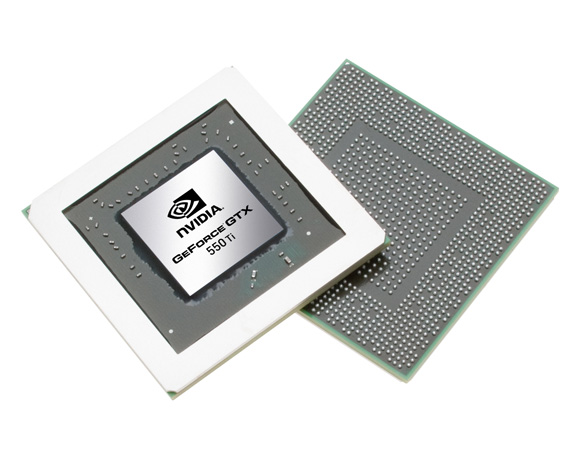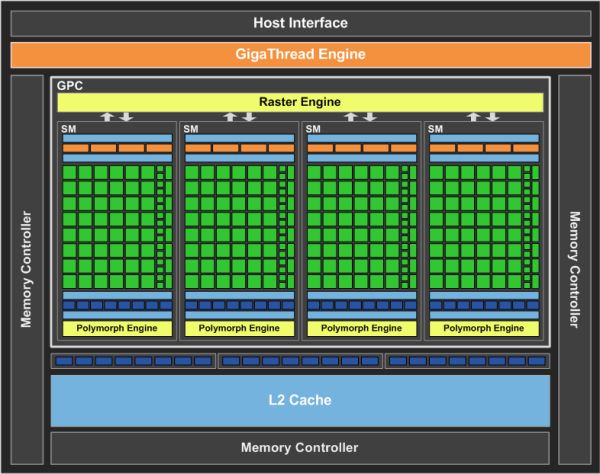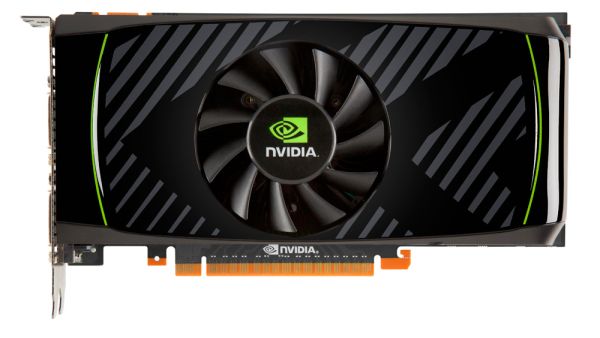NVIDIA's GeForce GTX 550 Ti: Coming Up Short At $150
by Ryan Smith on March 15, 2011 9:00 AM ESTThroughout the lifetime of the 400 series, NVIDIA launched 4 GPUs: GF100, GF104, GF106, and GF108. Launched in that respective order, they became the GTX 480, GTX 460, GTS 450, and GT 430. One of the interesting things from the resulting products was that with the exception of the GT 430, NVIDIA launched each product with a less than fully populated GPU, shipping with different configurations of disabled shaders, ROPs, and memory controllers. NVIDIA has never fully opened up on why this is – be it for technical or competitive reasons – but ultimately GF100/GF104/GF106 never had the chance to fully spread their wings as 400 series parts.
It’s the 500 series that has corrected this. Starting with the GTX 580 in November of 2010, NVIDIA has been launching GPUs built on a refined transistor design with all functional units enabled. Coupled with a hearty boost in clockspeed, the performance gains have been quite notable given that this is still on the same 40nm process with a die size effectively unchanged. Thus after GTX 560 and the GF114 GPU in January, it’s time for the 3rd and final of the originally scaled down Fermi GPUs to be set loose: GF106. Reincarnated as GF116, it’s the fully enabled GPU that powers NVIDIA’s latest card, the GeForce GTX 550 Ti.
| GTX 560 Ti | GTX 460 768MB | GTX 550 Ti | GTS 450 | |
| Stream Processors | 384 | 336 | 192 | 192 |
| Texture Address / Filtering | 64/64 | 56/56 | 32/32 | 32/32 |
| ROPs | 32 | 24 | 24 | 16 |
| Core Clock | 822MHz | 675MHz | 900MHz | 783MHz |
| Shader Clock | 1644MHz | 1350MHz | 1800MHz | 1566MHz |
| Memory Clock | 1002Mhz (4.008GHz data rate) GDDR5 | 900Mhz (3.6GHz data rate) GDDR5 | 1026Mhz (4.104GHz data rate) GDDR5 | 902Mhz (3.608GHz data rate) GDDR5 |
| Memory Bus Width | 256-bit | 192-bit | 192-bit | 128-bit |
| RAM | 1GB | 768MB | 1GB | 1GB |
| FP64 | 1/12 FP32 | 1/12 FP32 | 1/12 FP32 | 1/12 FP32 |
| Transistor Count | 1.95B | 1.95B | 1.17B | 1.17B |
| Manufacturing Process | TSMC 40nm | TSMC 40nm | TSMC 40nm | TSMC 40nm |
| Price Point | $249 | ~$130 | $149 | ~$90 |
Out of the 3 scaled down 400 series cards, GTS 450 was always the most unique in how NVIDIA went about it. GF100 and GF104 disabled Streaming Multiprocessors (SMs), which housed and therefore cut down on the number of CUDA Cores/SPs and Polymorph Engines. However for GTS 450, NVIDIA instead chose to disable a ROP/memory block, giving GTS 450 the full shader/geometry performance of GF106 (on paper at least), but reduced memory bandwidth, L2 cache, and ROP throughput. We’ve always wondered why NVIDIA built a lower-performance/high-volume GPU with an odd number of memory blocks and what the immediate implications would be of disabling one of those blocks. Now we get to find out.
Launching today is the GTX 550 Ti, which features the GF116 GPU. As with GF114 before it, GF116 is a slight process tweak over GF106, using a new selection of transistors in order to reduce leakage, increase clocks, and to improve the card’s performance per watt. With these changes in hand NVIDIA has fully unlocked GF106/GF116 for the first time, giving GTX 550 Ti the responsibility of being the first fully enabled part: 192 CUDA cores is paired with 24 ROPs, 32 texture units, 384KB of L2 cache, a 192-bit memory bus, and 1GB of GDDR5.
The GTX 550 Ti will be shipping at a core clock of 900MHz and a memory clock of 1026MHz (4104MHz data rate), the odd memory speed being due to NVIDIA’s quirky PLLs. If you recall, GTS 450 was clocked at 783MHz core and 902MHz memory, giving the GTX 550 Ti an immediate 117MHz (15%) core clock and 124MHz (14%) memory clock advantage, with the latter coming on top of an additional 50% memory bandwidth advantage due to the wider memory bus (192-bit vs. 128-bit). NVIDIA puts the TDP at 116W, 10W over GTS 450. GF116 remains effectively unchanged from GF106, giving it a transistor count of 1.17B, with the power difference coming down to higher clocks and the additional functional units that have been enabled.
Unlike the GTS 450 launch, GTX 550 Ti is a more laid back affair for NVIDIA – admittedly this is more often a bad sign than it is a good one when it comes to gauging their confidence in a product. As a result they are not sampling any reference cards to reviewers, instead leaving that up to their board partners. As with GF104/GF114, GF116 is pin compatible with GF106, meaning partners can mostly reuse GTS 450 designs; they need only reorganize the PCB to handle a 192bit bus along with meeting the slightly higher power and cooling requirements. As a result a number of custom designs and overclocked cards will be launching right out of the gate, and you’re unlikely to ever see a reference card. Today we’re looking at Zotac’s GeForce GTX 550 Ti AMP, a factory overclocked card that pushes the core and memory clocks to 1000MHz and 1100MHz respectively. The MSRP on the GTX 550 Ti is $149 - $20 more than where GTS 450 launched at – while overclocked cards such as the Zotac model will go for more.

As was the case with the GTS 450, NVIDIA is primarily targeting the GTX 550 Ti towards buyers looking at driving 1680x1050 and smaller monitors, while GTX 460/560 continues to be targeted at 1920x1080/1200. Its closest competitor in the existing NVIDIA product stack is the GTX 460 768MB. The GTX 460 768MB has not officially been discontinued, but one quick look at product supplies shows that 768MB cards are fast dropping and we’d expect the 768MB cards to soon be de-facto discontinued, making the GTX 550 Ti a much cheaper to build replacement for the GTX 460 768MB. In the meantime however this means the GTX 550 Ti launches against the remaining supply of bargain priced GTX 460 cards.
AMD’s competition will be the Radeon HD 6850, and Radeon HD 5770. As is often the case NVIDIA is intending to target an AMD weak spot, in this case the fact that AMD doesn’t have anything between the 5770 and 6850 in spite of the sometimes wide performance gap. Pricing will be NVIDIA’s biggest problem here as the 5770 is available for around $110, while AMD has worked with manufacturers to get 6850 prices down to around $160 after rebate. Finally, to slightly spoil the review, as you may recall the GTS 450 had a deal of trouble breaking keeping up with the Radeon HD 5770 in performance – so NVIDIA has quite the performance gap to cover to keep up with AMD’s pricing.
| March 2011 Video Card MSRPs | ||
| NVIDIA | Price | AMD |
| $700 | Radeon HD 6990 | |
| $480 | ||
| $320 | Radeon HD 6970 | |
| $240 | Radeon HD 6950 1GB | |
| $190 | Radeon HD 6870 | |
| $160 | Radeon HD 6850 | |
| $150 | ||
| $130 | ||
|
|
$110 | Radeon HD 5770 |












79 Comments
View All Comments
HangFire - Tuesday, March 15, 2011 - link
Advertisers hate it when you see how competitive older offerings are with new stuff. So, little-used features like in DirectX 11 are used to force out comparisons with older cards that still deliver great frame rates and value, and cause users to not upgrade for a while.We won this battle for a while and AT had a few older cards it included in its benchmarks. Now its back to nothing but the latest.
morphologia - Tuesday, March 15, 2011 - link
"Nothing but the latest?" The 4870 and 4870X2 shown in this comparison are hardly current. I suppose the 4870 is less likely to outperform than the 4890 is, but the X2 makes an even stronger showing. Still does not make sense.Also, on an unrelated note, it looked like the 6990 was dropping out of various comparison scales without explanation. BattleForge 1680x1050, for example. 6990 dominated the 1920x1200 but was inexplicably absent from 1680x1050, instead the 580 topped that chart. What's up with that??
Ryan Smith - Tuesday, March 15, 2011 - link
The 6990 is not on any of the 1680 benchmarks. It's already CPU limited at 1920; at 1680 it's useless data since no one is going to use it at that resolution.Ryan Smith - Tuesday, March 15, 2011 - link
Due to the amount of time it takes to benchmark (and rebenchmark) GPUs, it's necessary to keep a truncated list, and from there not every card actually makes it in to the article (and this is why we have GPU Bench). As such I focus on the current and previous generation of GPUs, while throwing in a sampling of 3rd & 4th generation GPUs as a baseline.I specifically pick these older GPUs based on architecture and relative performance - the idea being that while we don't have every GPU in the system, if it's a few years old it's well established how other minor variations of that GPU perform relative to the one in our results database. So in this case the 4870 is in there both because it's easy to visualize where the 4850/4890 would be relative to it, and because it was easily the most popular 4800 card.
morphologia - Tuesday, March 15, 2011 - link
Seems like the 4870X2 was a bit of a spoiler, seeing as how it trumped a few of even the current generation, though it too was dropping in and out of the bar charts with no explanation. If you are going to include it at all, there should be more consistency. Otherwise it looks like ranking/stat doctoring.7Enigma - Thursday, March 17, 2011 - link
Ryan's already mentioned why. It's a dual GPU card at the time was likely not tested at the low resolutions this particular article used for these lower-end cards. Likely 1920X1200 (or 1080) was the lowest this card was benchmarked at. I applaud Anandtech for including the data they have, and as mentioned you can use Bench to compare to your hearts desire. Bottom line: it is unlikely someone is gaming at less than 24" resolutions with a 4870X2, and if they are they can use Bench for that particular purpose.These guys have enough to do without going back and retesting cards from years ago. I'm just glad the data is in there.
nwarawa - Tuesday, March 15, 2011 - link
I didn't hear much complaining about the GTX460 768MB all this time : all the reviews were heralding its value. Now we have an even less powerful GPU, and 768MB suddenly becomes an issue? The heck with that. 768MB should be the standard configuration for this card, with a MSRP of $129. If you want high resolutions with AA, you should be getting a more powerful GPU as well. Nvidia should use a 768MB model of the GTX550 to phase out the 768MB GTX460, keep the 1GB GTX460 for awhile, and encourage more brands to bin their GTX560Ti's and make some 2GB models (I know Palit/Gainward does one, but no availability where I live). An overclocked 2GB GTX560Ti would be handy in a handful of games (GTA4 immediately comes to mind), and would compete well with a 6950... leaving the GTX570 to dance with the 6970, and the GTX580 to maintain its single-chip lead.HangFire - Wednesday, March 16, 2011 - link
768MB did not suddenly become an issue. Previous AT articles on the two 460's have repeated warnings that 768MB would soon be not enough memory.Agreed that if you lower the price enough, 768MB becomes "enough" as you are unlikely to be driving high resolutions with the corresponding large numbers of in-memory high resolution textures with a low-end card. At moderate resolutions, 768MB is enough.
Belard - Tuesday, March 15, 2011 - link
(AMD - you still suck for naming the SLOWER 6870 cards to replace the 5870s etc)LOL - this would be FUNNY if it wasn't so sad.
1 - The "State of the art" 550 Ti (Total idiot) card is 0~5% faster than the the 1+ year old ATI 5770. Really, other than for reference - 1280x1024 scores are useless for todays monitors. $120~140 means buying a 20" 1920x1080 monitor, $160~200 is a 21~22" model. I'm missing the 1920x1200 since its not so bloody narrow. I'd love to see a 26~27" that does 2560 x 1600 on the market.
So when comparing the results for 1920x1080, which is a STANDARD for today. The 550 is sometimes 0~3 fps faster, sometimes slower.
2 - Price!? The 5770 is easily 1/3rd cheaper going for $100~125 vs, $150~160.
3 - Stupid model names!? GeForce was given to the series. So WTF is GFX good for? If the 550 is almost the bottom end... why not GTS like the GTS 450 or GTS 250? There is no consistency. It doesn't donate feature sets.
"TI" okay... What is the difference between a TI and a NON TI card? Oh yeah, the letters on the box and in bios, nothing else. Why bother?
We know Nivdia will most likely skip the 600 series (What happened to the 300s?) so they too can be "7s" with ATI. So well we see:
Nvidia GeForce GT 720 mx
Nvidia Geforce GTS 740 Pro
Nvidia Geforce GTX 780 Ultra
The Geforce 550 or "GF550" is ALL we need to know what the product is.
4 - ATI 6850... it should have been included in this benchmark since its in the same price range. Newegg as them for $150~180 ($160 avg). It would really show what people are paying for. The 6850 is about 10fps faster than the 5770/GF550
5 - GF 460-768 price is $130~160.. again, about 10fps faster than the GF550. But oh yeah, the 550 replaces the older and faster card. hate it when that hapens!
Think I'll hold on to my ATI 4670 until the AMD 7670/7770 comes out... I want the performance of a 5870/6950 with the heat/noise and power issues of a 5770 at a price under $180.
phoible_123 - Tuesday, March 15, 2011 - link
I find it kind of interesting that nVidia's price points for their mid-range cards are higher this time around.The GTX460 started at $220 IIRC (and had its price cut pretty quickly), while the GTX560 is $259. The price for the 460 was pretty killer, but by the time the 560 came out, the pricing was pretty ho hum. If they had launched it at the same price level as the 460, AMD wouldn't have been able to compete. Granted, I'm sure they priced it that way to keep margins high, but this is a process improvement rather than an all-new chip (basically it's the third-gen gf100)...
The GTS450 was $130, while the GTX550 "TI" is $150. And when the GTS450 came out, the value prop wasn't that good (when compared to the 460). It's like half the card for only a little less money.
I recently picked up a GTX460 768MB for $90 after rebates.
It's kind of like the radeon 48xx vs 57xx comparison (less card for more money).